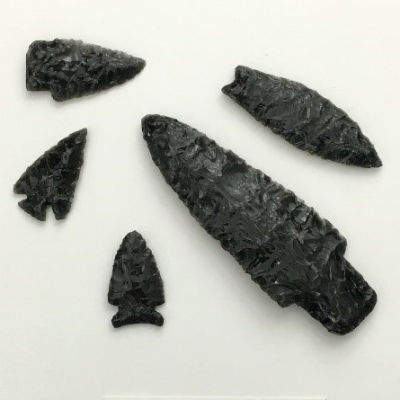Last updated: July 31, 2019
Lesson Plan
Atomic Elements and Archeology: Tracing Ancient Resource Access and Trade Routes Using XRF

- Grade Level:
- Middle School: Sixth Grade through Eighth Grade
- Subject:
- Science,Social Studies
- Lesson Duration:
- 60 Minutes
- Common Core Standards:
- 6.RI.4, 6.RI.7, 6-8.RST.1, 6-8.RST.3, 6-8.RST.4, 6-8.RST.7
- Thinking Skills:
- Remembering: Recalling or recognizing information ideas, and principles. Applying: Apply an abstract idea in a concrete situation to solve a problem or relate it to a prior experience. Analyzing: Break down a concept or idea into parts and show the relationships among the parts. Evaluating: Make informed judgements about the value of ideas or materials. Use standards and criteria to support opinions and views.
Essential Question
How do archeologists use scientific analysis of artifacts to study life within the past? How can an object’s molecular composition illustrate larger themes such as trade and cultural interaction?
Este plan de clase con actividades incluido también está disponible en español.
Objective
1. Learn how and why archeologists use molecular analysis, specifically x-ray fluorescence (XRF), to learn more about ancient objects and people.
2. Understand the scientific process behind XRF and how archeologists interpret their results.
3. Gain knowledge of scientific principles such as atomic structure and behavior.
Background
Archeology is an interdisciplinary field that utilizes a wide range of historical and scientific methodologies to study human life in the past. When analyzing a site, archeologists use techniques from multiple fields such as biology, geology, and chemistry.
X-ray fluorescence (XRF) is one scientific method that archeologists use to analyze artifacts found at a site. XRF analyzes which elements are present within an object and the quantity of each, creating an elemental “fingerprint” for the artifact. Archeologists then compare this fingerprint to local and non-local material sources such as clay beds or rock features. If the fingerprints match, they can assume that the object was created using material from that source. This process helps archeologists understand how ancient peoples obtained raw materials and tools, whether through local access or trade.
Overall, this lesson uses XRF as an example to connect scientific techniques and historical analysis. When these methodologies are used together, they produce a much deeper understanding of the everyday lives of past humans.
Preparation
Students will need pens/pencils and scrap paper.
Materials
Download XRF Teacher Answer Key
Download En Español: Archeología y XRF
Download En Español: Actividad: Análisis de XRF
Download En Español: Hoja de respuestas Análisis de XRF
Lesson Hook/Preview
This lesson introduces students to x-ray fluorescence, a scientific method used by archeologists to analyze how people within the past used and moved across the landscape. Using a case study from Yellowstone National Park, it illustrates how principles, such as atomic structure and behavior, can be used to address themes of resource access, trade, and cultural interaction.
Procedure
Step 1: Provide each student with a printed copy of the resource pages (Introduction through Activity).
Step 2: Have students read the provided background information about archeology, x-ray fluorescence, and stone (lithic) tools.
Step 3: Have the students complete the simulated XRF stone tool material sourcing activity. Review their answers.
Vocabulary
Archeology: also spelled “archaeology,” the scientific study of humans in the past
Artifact: an object created and used by people in the past
Energy levels: the different electron orbits around an atomic nucleus
Fluorescence: the secondary x-ray energy emitted by atoms
Lithic: referring to stone
Spectrometer: a scientific instrument that uses x-rays to identify separate elements within an object
X-ray fluorescence (XRF): a scientific tool that identifies elements
within an object and their varying quantities
Supports for Struggling Learners
Teachers can ask students to read the text out loud. After each section, teachers can review the main points with the students.
Enrichment Activities
Read the Archeology of Yellowstone: Obsidian: The MVP of Yellowstone’s “Stones” feature. Why is Obsidian Cliff both scientifically and culturally significant?
Additional Resources
Davis, Leslie B., Stephen A. Aaberg, James G. Schmitt and Ann M. Johnson. The Obsidian Cliff Plateau Prehistoric Lithic Source, Yellowstone National Park, Wyoming. Selections from the Division Of Cultural Resources Rocky Mountain Region, National Park Service No. 6. National Park Service, Denver, 1995.
MacDonald, Douglas H. Before Yellowstone: Native American Archaeology in the National Park. University of Washington Press, 2018.
MacDonald, Douglas H. and Elaine S. Hale, editors. Yellowstone Archaeology: Northern Yellowstone. Douglas H. Macdonald University of Montana Department of Anthropology contributions to Anthropology 13(1), 2011.
MacDonald, Douglas H. and Elaine S. Hale, editors. Yellowstone Archaeology: Southern Yellowstone. University of Montana Department of Anthropology contributions to Anthropology 13(2), 2013.
